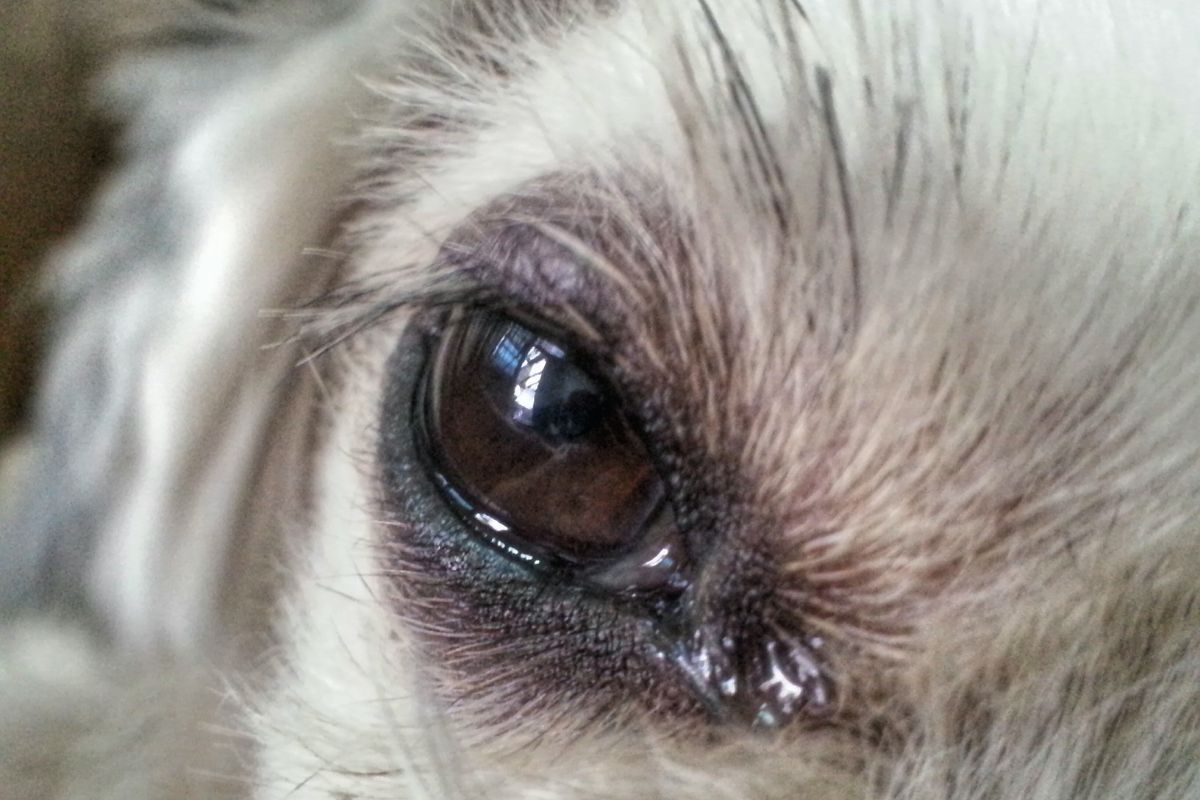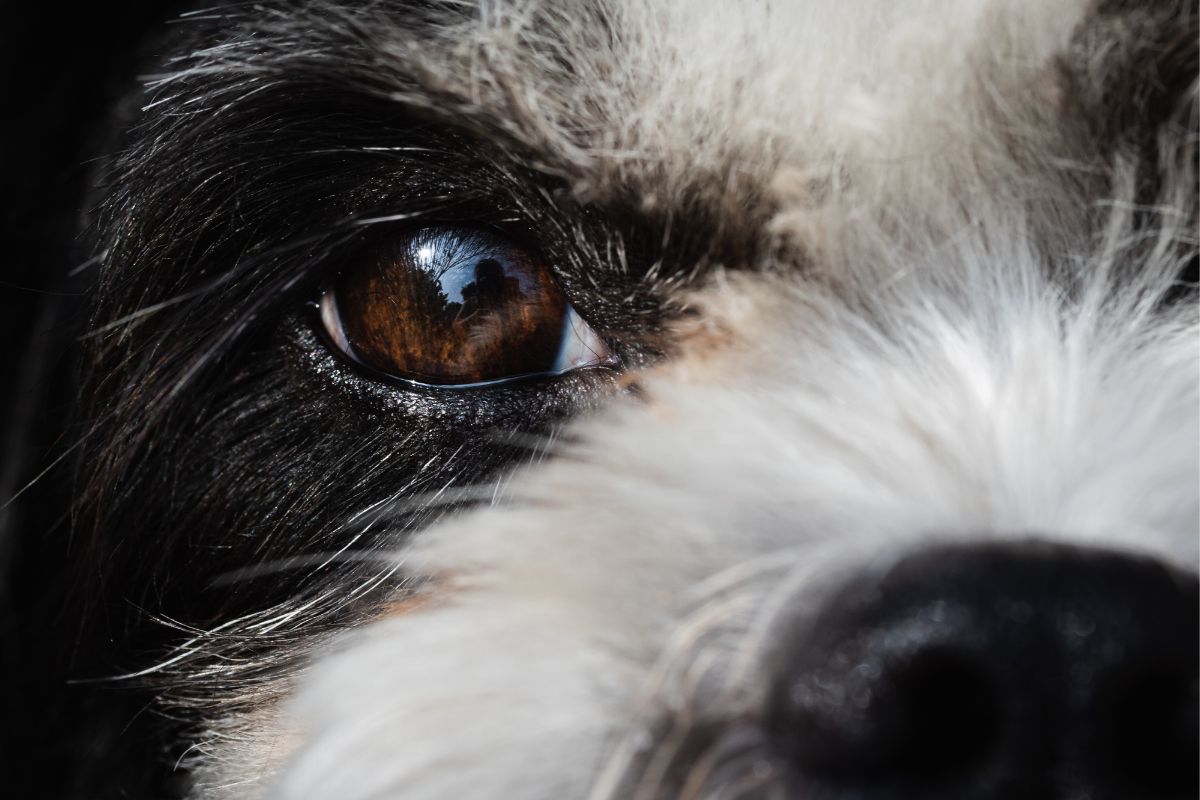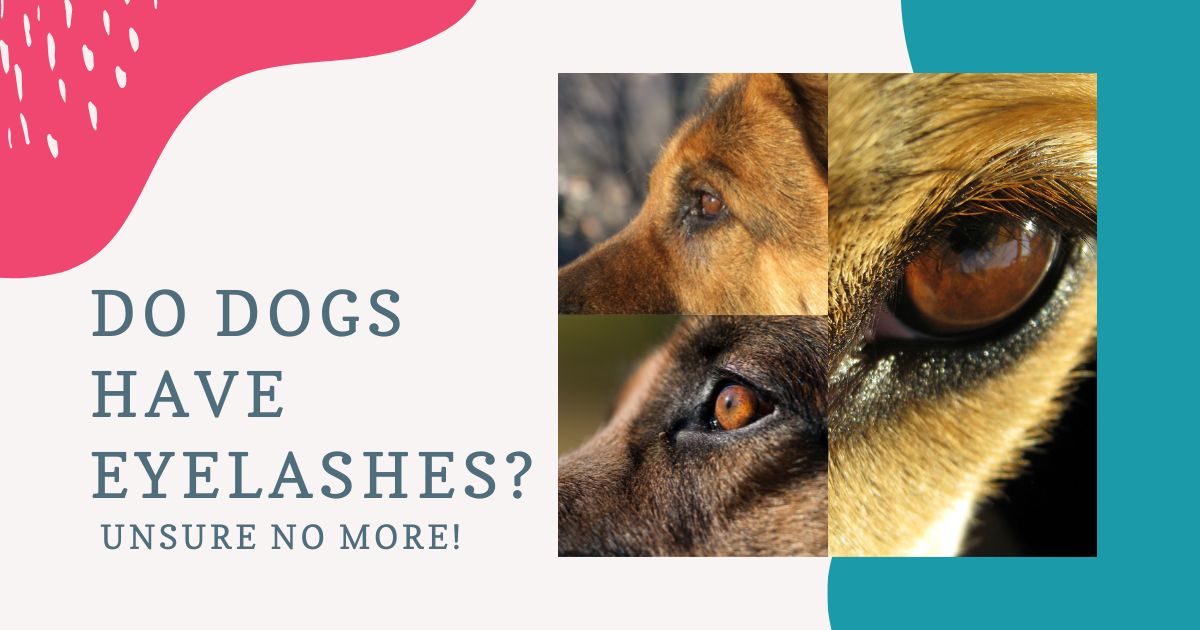Dogs and Eyelashes
You may be asking yourself, do dogs have eyelashes? Do their eyes require the same level of protection as ours, which our eyelashes and eyebrows provide? And if they do, as the dog’s owner, would it be acceptable for you to trim these individual hairs on the dog? Keep reading, and this article will answer all your questions.

Do Dogs Have Eyelashes?
Many people wonder, do all dogs have eyelashes? Yes, dogs do possess eyelashes, which are there to protect their eyes. In the same way, eyelashes protect human eyes from foreign objects and debris; a dog’s eyelashes do the same for a dog’s eyes. This is especially important if the dog spends a lot of time playing outside and frequently comes into close contact with bushes.
They rely on their eyelashes to shield their eyes from the sun’s glare and protect them from their hair or fur, which, if left unchecked, can grow long and even reach into the animal’s eyes.
In contrast to us humans, dogs’ eyelashes emerge only from their top eyelids. The only exception to this rule is if the dog develops a disorder known as “distichiasis,” which we will discuss in more detail in the following section.
Why Do Dogs Have Eyelashes?
Both people and dogs have eyelashes, which not only perform functions comparable to one another but also have the potential to create issues if you do not maintain them properly.
It is essential to keep this in mind because, even though the eyelashes on your dog may not be as noticeable as the ones on your own eyes, this does not mean that you should ignore them or treat them as if they do not exist. Instead, you should treat them with the same care and attention that you would give to your eyelashes.
You should carefully examine your dog’s eyelashes regularly and groom them well. This is because the eyelashes and the rest of your dog’s fur, nails, and teeth need you to groom, clean, and inspect them to ensure they remain in good health.
Consider your dog’s eyelashes a far more delicate and sensitive body part than your own. You can remove any stray eyelashes from your eyes on your own, and you can easily assess whether or not your eyelashes are causing any issues with your vision. Conversely, your dog cannot take care of itself similarly.
Therefore, it is up to you to ensure that your four-legged friend’s eyelashes have a healthy appearance and do not cause discomfort to their eyes. In addition, you must pay attention to the length and appearance of your dog’s lashes, making sure to take the appropriate steps of care based on the type of lashes your dog has.
This is especially important if you want your dog’s lashes to look their best. You should bear in mind that the eyelashes on your dog may be highly different from those on other dogs, which means that how you take care of your dog’s eyelashes may differ from how your next-door neighbor or best friend takes care of their dog’s eyelashes.
Your dog may have lashes that are extremely long, extremely short, have a double set of lashes, or even a row of lashes on the lower lid. Your dog’s lash options are endless. To protect oneself from illness and infection, it is necessary to take care of each type of lash in a specific and systematic manner.
Keep in mind that taking preventative measures is the most effective strategy to avoid any issues associated with the eyes and the eyelashes.
Do Dog Eyelashes Grow Back?
Let’s imagine you take your dog to the groomer. When you pick up your four-legged buddy, you discover that the groomer cut your dog’s eyelashes, despite your repeated requests that they remain in their natural state.
Like the rest of the hair on their bodies, don’t worry if the groomer hacks off or trims to an inappropriate length. It will take around five to six weeks for them to grow back, at which point your dog’s eyelashes will be back to the length they were before someone clipped them.
Dog Breeds With Long Eyelashes
As we discussed earlier, most canines have short eyelashes. However, because their eyelashes perform a useful purpose, their length depends on the length of their hair, particularly the long fur surrounding their eyes, to provide protection.
Those canine breeds that naturally have long hair, such as the following, are more likely to have long eyelashes due to their genetic make-up.
- Cocker Spaniels
- Maltese
- Yorkshire Terriers
- Lhasa Apsos
- Shih Tzus
- Poodles
Fun fact: the Guinness World Record holder for longest eyelashes as of 2014 is an Australian Labradoodle in Tokyo, Japan named Ranmaru, whose eyelash measured 6.69 inches (17 centimeters) at the time. Before Ranmaru, the previous holder of this world record was a Lhasa Apso. Before that, it was a Cocker Spaniel. Ranmaru broke both of these records.

Can You Cut Dogs’ Eyelashes?
Trimming a dog’s eyelashes as part of grooming a dog is possible. However, suppose the eyelashes do not cause discomfort for your dog; it may be best to leave them alone and ensure they do not get entangled in their fur.
The eyelashes of most dogs are relatively short, but certain breeds of long-haired dogs naturally grow longer eyelashes. This helps to shield the dogs’ eyes from any dust or debris that may become lodged in their long fur and cause irritation or infection.
It is typically up to the owner’s discretion to determine whether or not you should trim the eyelashes. You are most likely to trim the long-haired dog breeds’ eyelashes occasionally. On the other hand, some dog owners will request that the groomer only clip the fur around the dog’s eyes and keep the eyelashes at their natural length.
Eyelashes are important in protecting your dog’s eyes, so try to leave them alone or trim them only to improve the dog’s comfort level. This is more of a matter of preference for the dog owner.
Still, the bottom line is that eyelashes serve an essential function of protecting your dog’s eyes.
In addition, you should inspect their eyes regularly to ensure that they have a healthy appearance and are clear of debris.
Should You Trim a Dog’s Eyelashes?
Trimming a dog’s eyelashes depends on whether the lashes provide a potential threat of infection or injury to the eyes. It is not necessary to clip your dog’s eyelashes if they are not turning inward or appear to be an unsafe length. In this case, you should not go into the trouble of doing so.
Suppose you see that your dog’s eyelashes matt together or appear to irritate its eyes in any other manner, and you should give it a short trim. However, take care not to trim the eyelashes any shorter than necessary. If you cut the eyelashes too short, your pet will be in danger from potentially hazardous environmental elements.
If you let the eyelashes grow too long, you risk the lashes poking your pet’s eyes, which could lead to eye problems in your animal companion.
Should Dogs Have Long Eyelashes?
If you properly brush out your dog’s eyelashes and keep them in good shape, your dog technically has the potential to have long eyelashes. On the other side, longer eyelashes have the potential to attract other potentially harmful particles if they can touch the fur of your dog.
This is because your dog’s fur attracts dust, pollen, and other forms of debris. You can then transport the material to your dog’s eye, which might result in a worsening of the condition as well as disease.
Long eyelashes can also start to curl, which can end up pricking your dog’s eyes and lead your dog to paw at its eyes. You can prevent this by trimming the eyelashes regularly. This kind of conduct is also capable of causing a wide variety of infections of varying types.
In most cases, it is best to trim your dog’s eyelashes so they are neither excessively long nor excessively short. As you can see, either extreme can put you at risk of contracting an illness or a sickness. It is prudent to maintain the lashes at a length that does not place your animal companion in a precarious position where they could get injuries.
The Canine Breed With the Longest Eyelashes
Eyelashes are a natural defense against foreign particles such as pollen, dust, and debris for both people and dogs. The majority of canine breeds have eyelashes that are comparable in length to the length of their hair. Long-haired breeds typically have longer eyelashes, which assists in keeping their fur’s veil from falling into their line of vision.
There is a breed of dog called the Lhasa Apso that is famous for having long eyelashes and currently holds the record for having the longest eyelash on a dog in the world. One of the eyelashes of Prince Albert, a Lhasa Apso, measures 5.35 inches (13.6 centimeters), giving him the title of having the longest eyelashes in the world according to the Guinness World Records.
The Lhasa Apso is a breed of Tibetan origin that dates back centuries. As early as 800 B.C, people kept the dogs as friends and inside watchdogs, according to the available records. 1933 marked the beginning of Lhasa’s Apso importation into the United States.
In 1935, the American Kennel Club granted the breed official recognition; in 1975, the United Kennel Club did the same. These toy-sized canines have thick coats of hair that reach the floor, insulating them from the bitterly cold temperature of the Tibetan Himalayas. The eyelashes of these animals prevent the lengthy fur from getting into their eyes.
Eyelash Disorders in Dogs
There are several potential health problems that dog eyelashes might cause. The following is a list of some of the most frequent disorders.
Trichiasis
The disorder known as trichiasis occurs when hairs from their typical follicle placements become misdirected toward the eye and rub against the cornea or the inner lining of the eyelid. It can happen if a dog has particularly long eyelashes or facial hair or if the eye of the dog has past injuries.
Trichiasis is more common in younger dogs, brachycephalic (short-nosed) breeds like the Pekingese, Pug, Shih Tzu, Lhasa Apso, Bulldog, and breeds like the American Cocker Spaniel that have long hair around their eyes.
Symptoms
Symptoms of trichiasis include excessive eye watering (epiphora), pain, itching, squinting or blinking, dark pigmentation of the eye, blood vessels in the cornea area, and the possibility of an eye infection.
Trichiasis can also cause dark pigmentation in the eye. Trichiasis frequently results in the development of tear stains on the fur below the eyes of affected dogs. Your veterinarian may recommend surgery as a solution to fix the problem.
Distichiasis
There is a possibility that your dog with lashes could have an eyelash condition known as distichia, which causes the eyelash to develop in an irregular spot along the eyelid. One possible location for the growth of distachia is in the meibomian glands, which are responsible for producing lubricants for the eye.
Even though dogs do not have eyelashes on their lower eyelids, you can find these aberrant hairs on either the upper or lower lid. The medical term for this ailment is distichiasis.
It is not clear why some eyelash follicles sprout in these atypical locations, but veterinary professionals believe that the problem is genetic in some breeds of dogs. The following are examples of some of these breeds:
American Cocker Spaniel, Cavalier King Charles Spaniel, Shih Tzu, Lhasa Apso, Dachshund, Shetland Sheepdog, Golden Retriever, Chesapeake Retriever, Bulldog, Boston Terrier, Pug, Boxer Dog, and Pekingese.
Symptoms
The degree of your dog’s distichiasis will determine the severity of the symptoms, including redness and irritation, eye discharge, pain, excessive tears (epiphora), and excessive blinking or squinting of the eyes.
If you do not treat the dog’s cornea, it may get ulcerated, which will seem bluish and have less shine. The dog can paw at the injured eye if it is causing it discomfort.
Ectopic Cilia
A short, rigid eyelash known as ectopic cilia is a growth that can occur on the underside of either the upper or lower eyelid. This aberrant eyelash grows inward toward the eye, making blinking a pretty unpleasant experience for the sufferer.
Symptoms
It is common for dogs with ectopic cilia to have excessive tearing, redness, and sometimes even discharge and corneal ulcerations. Because these hairs are typically not noticeable to the human eye, it is essential to have your veterinarian examine your puppy using a portable microscope.
Suppose it turns out that your puppy does have ectopic cilia. In that case, the veterinarian can treat the condition through surgical removal or maybe with cryotherapy, also known as freeze therapy, while the animal is under anesthesia.

Final Words
In point of fact, all dog breeds are born with eyelashes and continue to have them throughout their lives; nevertheless, the length of the eyelashes is directly proportional to the length of the dog’s fur.
The eyelashes of a dog have two purposes: one is to shield the eyes from the damaging effects of direct sunlight, and the other is to shield the eyes from foreign particles such as dust and debris that may cause illnesses.
Unfortunately, even though the primary purpose of a dog’s eyelashes is to shield the eyes, they can occasionally become a source of unwelcome complications if you do not treat and manage them appropriately.
Because of this, paying close attention to your dog’s eyelashes is particularly vital if you want to ensure that the eyes remain healthy.

